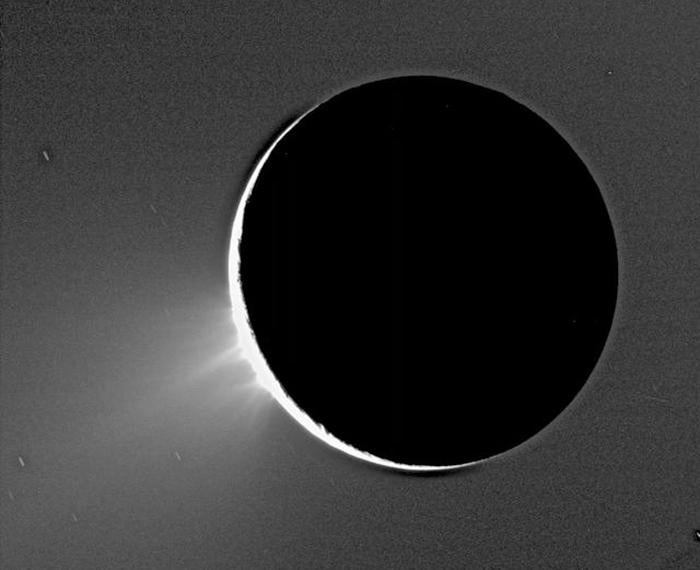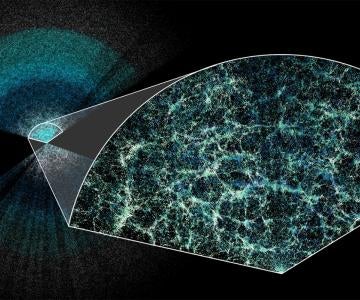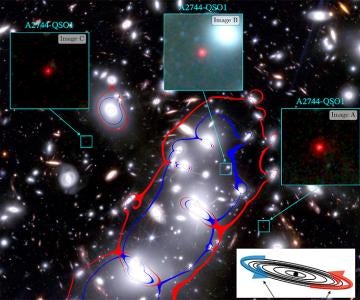
Subscribe to Pittwire Today
Get the most interesting and important stories from the University of Pittsburgh.We should investigate Saturn’s moon Enceladus for life beyond Earth, this Pitt volcanologist says

When it comes to finding life elsewhere in our solar system, there’s a lot of talk of Mars and Europa, one of Jupiter’s moons.
But Ian Flynn, a postdoctoral fellow in the Dietrich School’s Department of Geology and Environmental Science, is planning his own trip to look for life, and he has his sights set elsewhere.
“Enceladus has equally as convincing evidence to have life on it,” he said.
Flynn (A&S ’22G) and a team of investigators are aiming for Saturn’s moon. They recently published their mission concept, Astrobiology Xploration at Enceladus (AXE): A New Frontiers Mission Concept Study in the Planetary Science Journal.
Enceladus is Saturn’s sixth-largest moon which, until recently, was thought to be a cold, uninteresting rock. Then, in the early 2000s, NASA’s Cassini mission determined there were plumes of water shooting out from beneath the moon’s surface. Subsequent missions found that there was organic matter, as well as other interesting compounds, in the water.
“We now want to determine if there are biological materials in these plumes,” Flynn said.
The AXE mission concept was developed at a NASA-sponsored science summer school at the Jet Propulsion Laboratory (JPL). The program is designed for early-career faculty and younger researchers.
“NASA developed a program to educate the next generation,” Flynn said. “We learned how to develop a mission from start to finish.” Near the end of the program, his research group had the opportunity to work with JPL engineers to iron out any engineering wrinkles that geologists, chemists and astrobiologists might not have had much experience with. Then they presented their ideas to a panel of current and former JPL and NASA employees.
“When the program ends, usually participants scatter, and they’re done,” Flynn said. But his group’s proposal was so well received, they decided to publish their work, which is essentially a proof of concept and a steppingstone to getting a mission to Enceladus off the ground.
The mission they proposed would send a vessel to investigate the plumes, using chemical analyses to determine if the water holds any biological material — life. As part of the mission concept, Flynn was responsible for figuring out how to manage communications between the craft and Earth, a skill he learned at JPL. He also provided insight into developing thermal-infrared instruments — cameras that can trace the water by using its heat as a signal to trace the origin, or origins, of the plumes. Are they from one source, like a geyser, or is the water being ejected at different locations from the same water source?
“Also, Enceladus is pretty dark,” Flynn said. The moon doesn’t get much sunlight; it gets Saturnshine, light reflected off the planet and its rings. An infrared camera is more sensitive to lower levels of light and will allow the team to take better photos of the surface.
For the proposed mission, Flynn would also do work that resembles the research he does studying volcanoes here on Earth and other planets like Mars and Venus. On Enceladus, however, he’ll be looking at the morphology, or the shape and structure, of the vents at the planet’s south pole.
For Flynn, developing or leading a mission is one of his career goals. It’s a timely aspiration: In its 10-year list of priorities for the coming decades, NASA listed a mission to Enceladus as one of its highest priorities alongside missions to other watery worlds, including Europa and Titan.
“Europa is going to be an awesome mission, same with Titan. They also have unusual features, and they might have life on them,” Flynn said, “Enceladus, with its water and plumes and already identified organic materials, makes an equally, if not more compelling, case for exploration.”
— Brandie Jefferson, image of Enceladus courtesy of NASA/JPL/Space Science Institute




